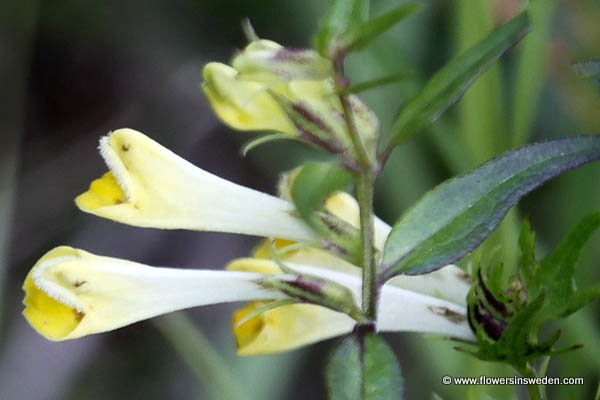
Location: Hammarstrand
| Scientific name: | Melampyrum pratense L. | |
| Swedish name: | Ängskovall, kovall | |
| German name: | Wiesen-Wachtelweizen | |
| Nederlandse naam: | Hengel | |
| English name: | Common Cow-wheat, Black Corn | |
| Plant Family: | Orobanchaceae, Broomrape family, Lejongapsväxter |

Location: Hammarstrand |
| Life form: | Annual | |
| Stems: | Slender, branched | |
| Leaves: | Opposite, sessile, linear-lanceolate | |
| Flowers: | Single, long-tubed pale yellow flowers in the axils of the upper leaves in pairs, all turning one way; green leafy bracts | |
| Flowering Period: | July-August | |
| Fruits: | The oval seeds grow in fruits each containing four seeds; dispersed by ants, which feed the fatty attachment to their larvae | |
| Habitat: | Woods, moorlands, pastureland and meados |

Derivation of the botanical name: Melampyrum, from the Greek melas, "black" and pyros, "wheat", because the seeds made bread black when mixed with them. pratense refers to its habitat, moist meadows.
It has an interesting relationship with Wood ants (Formica spp.). Melampyrum pratense has small glands on the underside of its lower petals, which release a sweet liquid upon which the ants feed. The plant's seeds resemble ant cocoons and, mistaking the seed for the 'real thing', the ants take the seeds to their nests, helping to disperse them. In areas that have been deforested, such plants cannot return with the aid of ants, and this understanding is crucial when attempting to restore woodland ground flora to areas which have been deforested for a long time. Carl Linnaeus (1707-1778): "When cows are fed in fields where the 'Meadow Cow-wheat' is abundant, the butter yielded by their milk is peculiarly rich and of a brilliant yellow colour". 
|